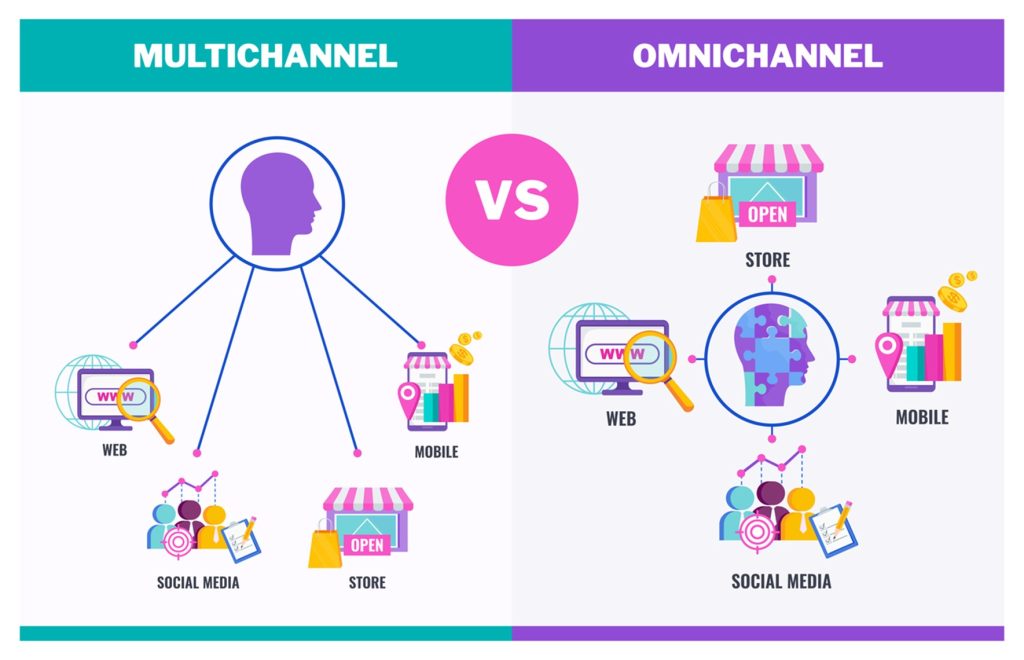People often use the terms multichannel and omnichannel interchangeably when describing their marketing strategies. Multichannel marketing and omnichannel marketing are both strategies that involve using multiple channels to reach customers and promote products or services. However, there are a few key differences between the two.
What is Multichannel Marketing?
Multichannel marketing focuses on sending a common message to a consumer across different channels. For example, you may advertise a sale on social media and send an email to your customers announcing the sale.
What is Omnichannel Marketing?
Omnichannel marketing focuses on the customer experience and using multiple, connected channels to get a consumer to engage and move through the purchase funnel. For example, you may send your customer an email announcing a new product, and while on Facebook, they are offered a code for that same product with the same visual, and on Instagram, they see a customer story about using the product.

What are the Differences Between Multichannel and Omnichannel Marketing?
Here are a few things to keep in mind when looking at the difference between multichannel and omnichannel marketing tactics:
- Focus: Multichannel marketing focuses on using multiple channels to reach customers and promote products or services. Omnichannel marketing, on the other hand, focuses on creating a seamless and consistent customer experience across all channels.
- Integration: In multichannel marketing, each channel operates independently, with its own separate strategies and goals. In omnichannel marketing, all channels are integrated and work together to create a cohesive customer experience.
- Customer experience: Multichannel marketing may provide a good experience for customers on each individual channel, but the experience may not be consistent across all channels. Omnichannel marketing, on the other hand, aims to provide a consistent and seamless customer experience across all channels.
- Data and analytics: Omnichannel marketing relies heavily on data and analytics to track customer behavior across all channels and optimize the customer experience. Multichannel marketing may use data and analytics as well, but the focus is on each individual channel rather than the overall customer experience.
Most brands live somewhere in the in-between stages – often using multiple channels to reach consumers while some may be only partially integrated across all touchpoints.
Most importantly, an omnichannel approach is still a multichannel approach, as it offers customers more than one channel to learn about and engage with your brand. Omnichannel is then about finetuning and more closely interconnecting these channels.
Top 7 Multichannel Marketing Tactics
So while the goal is to become omnichannel, here are some multichannel marketing tactics that you should be using if you aren’t already:
1. Email Marketing
Email marketing is a highly cost-effective way with a great ROI popular for brands to drive customer acquisition and retention and effectively promote products or services.
- Email marketing has an average ROI of 4400%, meaning that for every $1 spent on email marketing, businesses can expect an average return of $44. (Source: Campaign Monitor)
- 49% of consumers said that they would like to receive promotional emails from their favorite brands at least once a week. (Source: Statista)
- Email is the preferred channel for receiving promotional content for 72% of consumers. (Source: MarketingSherpa)
2. Social Media Marketing
In today’s social age, platforms like Facebook, Instagram, and Twitter provide brands a way to connect with customers, share content, and promote products or services. By creating engaging and informative social media posts, social media marketing enables businesses to build their brand, increase engagement, and drive traffic to their website.
- More than half of the world’s population uses social media, with over 4.66 billion active social media users as of October 2021. (Source: Statista)
- Social media is the second most effective digital marketing channel for customer acquisition, following only email marketing. (Source: Hubspot)
- 54% of social media users research products on social media platforms before making a purchase. (Source: GlobalWebIndex)
- 71% of consumers who have had a positive experience with a brand on social media are likely to recommend the brand to their friends and family. (Source: Ambassador)
- Brands that engage on social media with their customers see an average of 20-40% higher revenue per customer. (Source: Bain & Company)
3. Connected TV (CTV) Marketing
The trend towards connected TV and streaming services is surging as more consumers are cutting the cord in favor of subscription-based TV viewing. CTV advertising is an incredibly effective channel to reach consumers with highly personalized and pinpointed campaigns.
- 85.0% of CTV viewers say they are likely to purchase a product or service after seeing a relevant ad. (Source: Innovid)
- CTV ads have an average completion rate of 95.0%, indicating that viewers are highly engaged with this type of content. (Source: Innovid)
- CTV advertising can improve brand lift by up to 2.4x, making it a highly effective way to increase brand awareness and drive sales. (Source: Roku)
4. Search Engine Optimization (SEO)
SEO involves optimizing a website to improve its visibility and ranking on search engines like Google. By optimizing their website for relevant keywords and phrases, businesses can increase their chances of appearing on the first page of search engine results, driving more traffic to their site.
- 53.3% of website traffic comes from organic search. (Source: BrightEdge)
- 75% of users never scroll past the first page of search engine results. (Source: HubSpot)
- SEO leads have a 14.6% close rate, compared to 1.7% for outbound leads like print ads or direct mail. (Source: Search Engine Journal)
5. Pay-Per-Click (PPC) Advertising
PPC advertising involves placing ads on search engines, social media platforms, or other websites and paying each time a user clicks on the ad. By targeting specific keywords or demographics, businesses can reach their desired audience and drive traffic to their website.
- Businesses make an average of $2 in revenue for every $1 they spend on Google Ads. (Source: Google Economic Impact Report)
- Paid search ads can increase brand awareness by 80%. (Source: Google)
- 65% of customers click on ads when they are looking to buy an item online. (Source: Clutch)
- PPC visitors are 50% more likely to purchase something than organic visitors. (Source: Unbounce)
6. Content Marketing
Content marketing involves creating and sharing informative and engaging content, such as blog posts, videos, and infographics, to attract and retain customers. By providing valuable content, brands can establish themselves as experts and build trust with their audience.
- Content marketing generates 3 times as many leads as traditional outbound marketing, but costs 62% less. (Source: DemandMetric)
- 72% of marketers say that content marketing increases engagement and builds loyalty with their audience. (Source: Content Marketing Institute)
- 70% of people prefer to learn about a company through articles rather than advertisements. (Source: Content Marketing Institute)
- Content marketing costs 62% less than outbound marketing and generates 3 times as many leads. (Source: Demand Metric)
7. Direct Mail Marketing
Direct mail involves sending physical mail, such as postcards or flyers, to customers or prospects. By targeting specific demographics or geographic areas, businesses can reach their desired audience and promote their products or services.
- 56% of customers consider print marketing to be the most trustworthy type of marketing. (Source: MarketingSherpa)
- Direct mail has a higher recall rate than digital advertising, with 75% of people able to recall a brand after receiving direct mail compared to just 44% for digital ads. (Source: Association of National Advertisers)
- 73% of consumers prefer direct mail for receiving marketing promotions from companies they have previously done business with. (Source: Data & Marketing Association)
- 40% of consumers have tried a new business after receiving direct mail from them. (Source: Small Business Trends)
Multichannel marketing involves using a variety of channels to reach and engage with today’s on-the-go consumers. By utilizing a variety of channels, businesses can increase their reach, engage with their target audience in different ways, and improve their overall marketing effectiveness. In fact, multichannel digital marketing campaigns can achieve 300% higher ROI than single-channel campaigns. The results are impressive!





